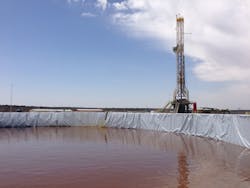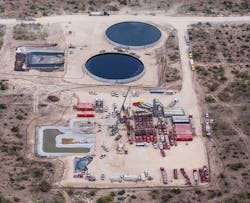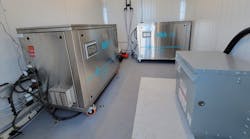Some of the most prolific oil and gas basins in the world are stashed away in arid or semi-arid areas such as the Permian Basin of west Texas. Hydraulic fracturing - which involves injecting between 10 and 21 million gallons (250-500K BBLs) of water into a well in order to break loose its trapped hydrocarbons - has been around for over 60 years. However, in recent years multiple efficiency and technology gains have proved the concept to be very productive. Its productivity has caused the procedure to explode in popularity across the nation and elsewhere.
On the other hand, in climates wet or dry, the issue of disposing of the floods of water later produced alongside the oil creates its own set of challenges.
This combination of issues has forced oil producers to find ways to economically capture, treat and reuse as much water as they can. To do this, they rely on water treatment companies.
Full water-life-cycle-management specialists like Fort Worth-based Bosque Systems have arisen due to the complexity of treating many types of water for many different uses. Treating all incoming water with the same procedure would be like buying every member of the Duggar family the same size pants: It would rarely work, and it could even be disastrous.
Water sources may include potable groundwater, briny groundwater, produced water from oil wells and, in rare cases, surface water. Treatment needs for these sources vary from simple to complex. To deal with these complexities Bosque Systems has developed a systematic approach for determining the process and monitoring its results. They used this system to treat 250 million barrels (10.5 billion gallons) of water in 2016.
Determining the Need
Bosque begins by meeting with the client during the client’s conceptual completion design phase. The time frame is typically 1-6 months before the project begins - the earlier the more complete the planning can be.
By determining the water’s source, content and use, Bosque can determine what and how much treatment it requires. From sourcing and treatment to use and, in some cases, disposal, the entire process must be considered before formulating a plan.
Part of the planning includes considering the need for equipment, onsite storage tanks, pumps and transportation. Planners also must include contingencies for maintaining proper treatment in the face of unexpected changes in the source, destination and amount of water being treated.
Knowing the source is important for logistics but it doesn’t necessarily determine the treatment. Some produced water needs little to no chemical treatment while some “fresh” water must be treated due to its high sulfate content.
Treating the Water
Sulfates, iron and total suspended solids (TSS) are the main culprits to be treated when present in concentrations of around 400 ppm (for sulfates). The exact level at which any of these must be treated depends on what other substances are present.
Sulfates, which can be present even in fresh water, tend to create scaling - particularly barium sulfate, which can quickly clog flowlines. Barium sulfate scale is particularly challenging to removal processes once it gets in place.
The problem with iron and TSS is that they inhibit the effectiveness of frack chemicals. Carried deep down into the well, these substances can limit the chemicals’ ability to affect the lubricity and viscosity needed to let the well flow efficiently as well as decrease the chances of formational damage.
Much of the treatment work simply involves filtration, especially for TSS issues. Depending on the situation, they may employ filters ranging from 400 microns to 3 microns. The smallest filters are typically required for reuse applications.
Storing, Transporting the Water
The amount of water produced, the quantity needed in completions and the ratio of produced water to fresh water dictate the type of storage used. The three most common storage vessels are frack tanks, in-ground pits and aboveground storage tanks. The water is transported by truck or by pipes.
Monitoring the Results
Any process requires constant monitoring and quality control, especially one whose product begins miles deep beneath the earth. Flowback water from wells changes, usually very gradually, as the well ages. The presence of frack chemicals, very strong at first, gradually declines over the life of the well.
As production continues, the flow may contain more connate water. Also known as fossil water, this formational liquid is denser and heavier than seawater and must be properly treated as its levels and viscosity change.
Water content can change quickly if a tank or pipeline handles water from multiple wells. This situation requires more monitoring.
At installation, Bosque technicians conduct initial testing at multiple inbound points. They then blend the water to test various treatment options to see which one is appropriate. While they do extensive pre-installation planning, no system is implemented until it proves successful in the field.
After the system is up and running, water tests continue at regular intervals by both Bosque technicians and third parties. This ensures that technicians adjust the treatment in order to maintain the consistency of the end product. Third-party testing serves as a backup to Bosque’s own evaluations and assures clients that the results are accurate.
Tolerances vary by project and by customer, but the goal is generally to minimize TSS levels to minimize previously stated frack chemical incompatibilities and other damage issues.
Personnel also conduct manual daily tests on the outbound water. Here, where the rubber meets the road, so to speak, the tolerances are very tight. The next step is to blend the water with the frack chemicals and inject it into the well, so all tolerances must be met at this point.
Throughout the reuse program Bosque monitors Key Performance Indicators (KPIs), compiling information for use in planning and executing future projects. This allows them to identify any “hurt points” as they term clients’ needs and how to address them.
Should oil prices continue to rise in 2017, drilling and fracking will also follow an upward path, making proper water use even more important. Well-planned and carefully monitored treatment and handling procedures are at the heart of responsible water use.
Bosque Systems is a leader in water management for oil and gas operators, specializing in water treatment, reuse and recycle, and disposal. To learn more, visit www.bosquesystems.com.




